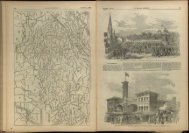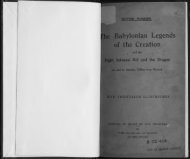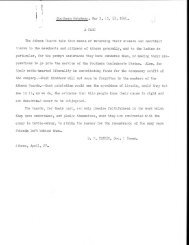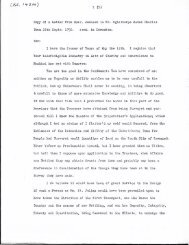THE SHE KING; OR, THE BOOK OF ANCIENT POETRY
THE SHE KING; OR, THE BOOK OF ANCIENT POETRY
THE SHE KING; OR, THE BOOK OF ANCIENT POETRY
You also want an ePaper? Increase the reach of your titles
YUMPU automatically turns print PDFs into web optimized ePapers that Google loves.
<strong>THE</strong> <strong>SHE</strong> AFTEE CONFUCIUS. <strong>THE</strong>EE DIFFERENT TEXTS.<br />
SECTION II.<br />
<strong>THE</strong> <strong>BOOK</strong> <strong>OF</strong> POETET FEOM <strong>THE</strong> TIME <strong>OF</strong> CONFUCIUS TILL<br />
<strong>THE</strong> GENERAL-ACKNOWLEDGMENT <strong>OF</strong> <strong>THE</strong> PEESENT TEXT.<br />
' From confu- ^ v the attention paid to the study of the<br />
cms to the dy- Book of Poetry from the death of Confucius<br />
nasty of Ts'in. , ,1 • rj ,-, m ,. , , ,<br />
to the rise ot the is in dynasty, we have<br />
abundant evidence in the writings of his graudson Tsze-<br />
sze, of Mencius, and of Seun K'ing. One of the acknow<br />
ledged distinctions of Mencius is his acquaintance with<br />
the odes, of which his canon for the study of them pre<br />
fixed to 'my larger volumes is a proof; and Seun K'ing<br />
survived the extinction of the Chow dynasty, and lived on<br />
into the times of Ts'in.<br />
2. The Poems shared in the calamity which all the<br />
other classical Works, excepting the Yih, suffered, when<br />
the tyrant of Tsfin issued his edict for their destruction.<br />
But I have shown, in the prolegomena to vol. I., that only<br />
The Poems a few years elapsed between the execution of<br />
3tSthe fire3 I decree and the establishment of the Han<br />
of Ts'in. dynasty, which distinguished itself by its<br />
labours to restore the monuments of ancient literature.<br />
The odes were all, or very nearly all, recovered; 1 and the<br />
reason assigned for this is, that their preservation de<br />
pended on the memory of scholars more than on their<br />
inscription upon tablets and silk. We shall find reason<br />
to accept this statement.<br />
3. Three different texts of the odes made their appear-<br />
differ- auce early in the Han dynasty, known as the<br />
ent taxts. She of Loo, of Ts'e, and of Han; that is, the<br />
In the last section reference was made to the number of the odes,<br />
given by Confucius himself as 300. He might mention the round number,<br />
not thinking it worth while to say that they were 305 or 311. The<br />
Classic now contains the text of 305 pieces, and the titles of other 6. It<br />
is contended by Choo and many other scholars, that in Confucius' time<br />
the text of those six was already lost, or rather that the titles were names<br />
of tunes only. More likely is the view that the text of these pieces was<br />
lost after Confucius' death.<br />
I<br />
Book of Poetry was recovered from three different<br />
quarters.<br />
[i.] Lew Hin's catalogue 1 of the Works in the imperial<br />
library of the earlier Han dynasty commences, on the She<br />
King, with a Collection of the three Texts in 28 chapters,<br />
which is followed by two Works of commentary on the<br />
Text of Loo. The former of them was by a The Text of<br />
Shin P'ei, of whom we have some account in Lo -<br />
the Literary Biographies of Han. He was a native of<br />
Loo, and had received his own knowledge of the odes from<br />
a scholar of Ts'e, called Fow K'ew-pih. He was resorted<br />
to by many disciples, whom he taught to repeat the odes,<br />
bnt without entering into discussion with them on their<br />
interpretation. When the first emperor of the Han<br />
dynasty was passing through Loo, Shin followed him to<br />
the capital of that State, and had an interview with him.<br />
The emperor Woo, in the beginning of his reign (B.C. 139),<br />
sent for him to court when he was more than 80 years<br />
old; and he appears to have survived a considerable<br />
number of years beyond that advanced age. The names<br />
of ten of his disciples are given, all men of eminence, and<br />
among them K'ung Gan-kwoh. A little later, the most<br />
noted adherent of the school of Loo was a Wei Keen, who<br />
arrived at the dignity of prime minister, and published<br />
" the She of Loo in Stanzas and Lines." Up and down in<br />
the Books of Han and Wei are to be found quotations of<br />
the odes, which must have been taken from the professors<br />
of the Loo recension; but neither the text nor the<br />
writings on it long survived. They are said to have<br />
perished during the Tsin dynasty (A.D. 265 419). When<br />
the catalogue of the Suy library was made, none of them<br />
were existing.<br />
[ii.] The Han catalogue mentions five different works on<br />
the She of Ts'e. This text was from a Yuen Koo, a<br />
native of Tsfe, about whom we learn, from the The Text of<br />
same chapter of Literary Biographies, that he Ts'e-<br />
was one of the Great scholars of the court in the time of<br />
the emperor King (B.C. 155 142), a favourite with him,<br />
and specially distinguished for his knowledge of the odes<br />
and his advocacy of orthodox Confucian doctrine. He<br />
died in the next reign of Woo, more than 90 years old;<br />
1 Proleg., Vol. I. p. 4.








